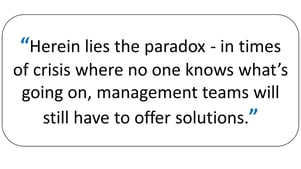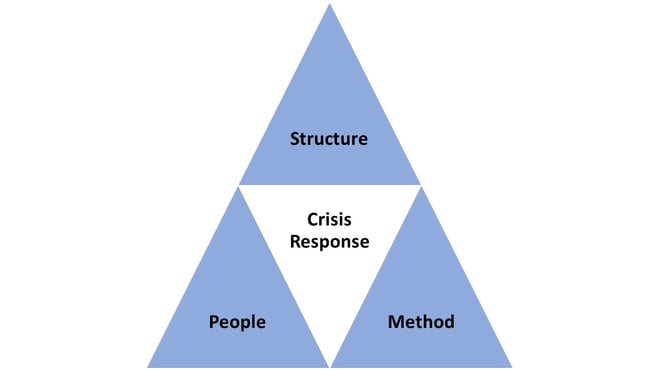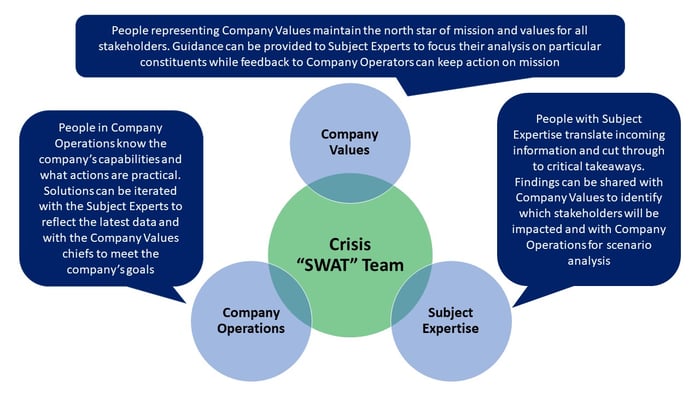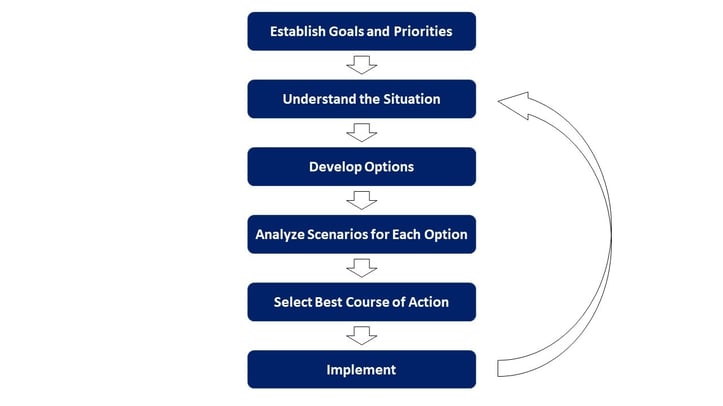Organizations look to their CEOs and managers for the steadying hand of direction. The general paradigm is that leaders see the path forward and make decisions to achieve that vision. In short, they have the answers. The paradigm especially holds true in times of great uncertainty. Whether it be COVID-19, an earthquake, or a financial meltdown, teams will look to their leaders for the same guidance and confidence that they expect in times of peace.
 Strong management teams would have, in the past, thought about disaster contingencies. In “routine” crises or ones that we’ve seen before, we have reliable, efficient, and “correct” answers to fall back on. Think about the average fire alarm and ensuing drill. However, there are crises that go beyond the regular. These events, termed in 1987 by the Army War College as VUCA (volatile, uncertain, complex, ambiguous) present a whole different set of challenges for leaders. VUCA situations like the 2008 mortgage crisis, the Fukushima disaster, or today’s COVID-19 pandemic are so unexpected and so devastating that while pre-planned courses of action might give us a head start, they are by no means sufficient in carrying the day.
Strong management teams would have, in the past, thought about disaster contingencies. In “routine” crises or ones that we’ve seen before, we have reliable, efficient, and “correct” answers to fall back on. Think about the average fire alarm and ensuing drill. However, there are crises that go beyond the regular. These events, termed in 1987 by the Army War College as VUCA (volatile, uncertain, complex, ambiguous) present a whole different set of challenges for leaders. VUCA situations like the 2008 mortgage crisis, the Fukushima disaster, or today’s COVID-19 pandemic are so unexpected and so devastating that while pre-planned courses of action might give us a head start, they are by no means sufficient in carrying the day.
So what do we do? Rather than providing unilateral answers or directives, leaders must create the best processes and environment for their teams to work collectively and decisively. Waiting for perfect information to take action is unrealistic - it’s like implementing safeguards to protect workers in grocery stores during COVID only after workers have died and their families have sued. As founders, CEOs, and business leaders, our biggest responsibility is figuring out how to navigate the choppy waters of a crisis. Yet, we should not walk the path of finding a solution alone. Even if our company is a 5 person startup that is iterating a product or a 30-person startup looking to scale, we have people around us who can offer perspectives that help move the organization forward. Below is a framework for managing through a crisis that we’ve seen work for founders and CEOs: Structure, People, Method.

Structure
As founders in crisis, our first step in setting up a good environment for collective action is identifying a core working team. This “SWAT” team for crisis management provides the nexus for information flows and decision making. 100% of the team’s time will be dedicated to overseeing all aspects of the response (e.g., logistical, operational, economic, medical, etc.). Standing up this team at the first sign of a VUCA event will help with speed of action - err on the side of proactively taking aggressive action rather than being reactive to rapidly deteriorating conditions and playing catch up. As founders, we need to identify and explicitly communicate the goals and responsibilities of the team. A few considerations:
- Collect and Analyze Information - The SWAT team spearheads finding and ingesting information about the crisis. In the case of COVID-19, keep track of the reports coming from the CDC, universities, research institutes as well as updates from government officials. The information collected naturally feeds into analysis to determine the trends and facts on the ground that are the basis of our go-forward strategy.
- Frame and Deliberate Key Questions - Even without full information, the SWAT team should identify the key questions facing the organization while taking into account competing priorities. VUCA events impact multiple stakeholders so having those perspectives represented (please see below section on “People”) is critical to developing and prioritizing question sets.
- Develop Action Plans - Important factor here is to align on an iterative process that the SWAT team can use as the situation unfolds. Please also notice the use of “plans” plural - a single plan won't work in a VUCA event. Again, we come back to establishing a robust process that can help the team translate evolving fact patterns into evolving solutions. (Please see below section on “Method”)
- Delegate Problem Solving and Execution - The SWAT team should delegate specific execution and implementation to the relevant people. This distributed leadership enables frontline employees to adapt the solutions to what they encounter. That said, the SWAT team should be explicit with the goals and the why of their plan to mobilize the entire organization around the same endpoint.
- Spearhead Communications - Likely the most important, our SWAT team will take charge of communications both inside and outside of the organization. Having a consistent, clear message internally will reduce confusion and ensure everyone on the ship is rowing in the same direction. Regardless of the size of our company, consistent messaging to external stakeholders such as suppliers, partners, and investors is key to establishing credibility and trust through uncertainty.
The specific responsibilities will naturally need to be customized to the specific crisis. As an example, an 8 person startup in LA encountered a data breach, exposing sensitive information of its clients. Not knowing the magnitude of the damage or the extent of the hack, the CEO convened a team of the CTO, Head of Partnerships, and Head of Growth and prioritized identifying and fixing the platform weakness and communicating with clients. With clear goals and responsibilities, the team quickly collected information to determine an action plan in which the CTO worked with the engineering team to patch or rebuild software and the rest of the team dedicated themselves to client management. By bringing together people from key parts of the company in a structured way, the CEO not only got different perspectives, but also speed in arriving at and implementing a solution.
People
Now that we have our SWAT team structure in place, whom should we include on that team? There are three perspectives that the SWAT team should represent. Even if our company is sub-20 people, there are people from different functions who can provide a thoughtful, differentiated view.
The first is the perspective of the company, its operations, customers, logistics, etc. that will provide a lens on actionability and impact of various solutions. The second perspective is that of the firm’s values, constituencies, and stakeholders. The people representing this view will maintain the firm’s north star and ensure that all needs are appropriately addressed. The third is that of a specialist who can quickly understand and translate the incoming data about the crisis and also provide perspectives on the future scenarios for the team to run. In the case of COVID-19, an expert on government policy, public health, or epidemiology can help translate and cut through the flood of incoming information for the team. And yes, there may likely be overlap in these groups. The critical aspect is providing enough coverage but keeping the group small enough to move quickly. This approach to people is just as critical for small startups. The smaller our team, the faster we can pivot - there are fewer layers of bureaucracy our message needs to traverse. For the first 2 perspectives, we have people in our organizations who can provide strong views on both company values and operations. For the specialist view, we should leverage our network. As leaders of small to medium-sized companies who might not have relevant experts on hand for VUCA events, we need to be scrappy and dig into our investor base, our Board, fellow CEOs, employees, etc. An example from Stage 2 - when government officials announced PPP in response to COVID-19, one of our portfolio companies found a policy expert through their Board member network to help them better understand the ramifications of PPP.

Method
Now that we have our SWAT team in place with clear responsibilities, we need to turn to the process for problem solving. Let me first dispel any delusions of grandeur - as a leader in a crisis, we will make mistakes and we will get things wrong. We need to figure out solutions in real time under tremendous stress without the whole picture - hold to one course of action too tightly and the changing circumstances will render that action not just irrelevant but potentially harmful. Actions should be treated as tentative and experimental. Luckily, experimental and rapid iteration are in our blood as technology and startup leaders. What does this method look like? You might already have a sense.

Conclusion
These three elements of an action plan must fit together seamlessly to successfully execute agile management. As leaders, a big part of our role is to establish and maintain a strong attitude and psychological frame throughout the crisis. Action is education; execution is learning. For dynamic problem solving, an open, exploratory mindset that assumes uncertainty and unknowns and that invites (dare I say requires and celebrates) candor are not luxuries, but necessities. In uncertainty, inquiry trumps advocacy. At this point in the COVID-19 crisis, the notion of empathizing with our customers and relating to those around us became standard practice. But let’s take it one step further - let’s invite and encourage those around us to voice their radical (and relevant) ideas, questions, and concerns. It’s counter-intuitive to think that creating the space for mistakes and failures will lead to fewer mistakes and failures - but let me put it this way: failure in the war room hurts a lot less than failure in the market, with employees, and with customers. A classmate of mine, a former US Army Green Beret with 3rd Special Forces Group, once told me a hack that I’ve used on many occasions. In a sticky situation, ask what’s the most likely situation and what’s the most devastating situation. Having contingencies for these two questions will cover 80% of the scenarios that may arise.
The old way of top down command and control is dead. That’s not to say we should abdicate our leadership roles. Rather, our experience and expertise in harnessing the power of our teams should help us create an environment for joint success. So to today’s and future crises, I’d say, bring it on! We, as leaders, are ready to counter attack head on.


